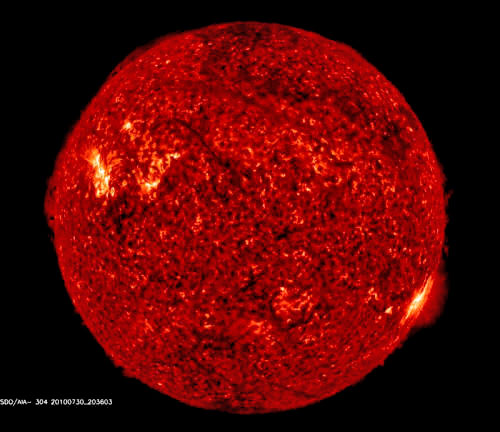|
by Jon Lockton August 2, 2010 from WelcomeToAFreeWorld Website
CME sunspot solar flare
On Sunday, NASA's Solar Dynamics Observatory detected a complex magnetic eruption on the sun.
The NASA Solar and Heliospheric Observatory (SOHO) also spotted a large coronal mass ejection (CME). The eruption happened around (3:50 am EST), the SDO detected a C3 class solar flare originating from a group of sunspots (called sunspot 1092).
Massive Solar Eruption, Sunspot 1092 2010 August 01
The flare itself was not that large, but the filament located about 70,000 miles away erupted at the same time.
The flare and filament erupted at the same time, this suggests they are connected by long-range magnetic field lines. Some believe the flare may have accelerated the eruption of the filament.
Eventually, a giant magnetic bubble of
plasma broke and blasted out into space.
They drive shock waves which produce energetic particles that can be damaging to both electronic equipment and astronauts that venture outside the protection of the Earth's magnetic field.
Expect the government and all observatories to be on high alert.
They know a CME is coming, they can probably prepare for its arrival.
The reason I find this particular story interesting is because the event being discussed continues to happen more frequently, and on a larger scale than prior events of such a magnitude.
We will see how this particular CME effects earth on August 3rd.
It will effect the area of earth facing the sun.
Coronal mass ejection headed for Earth
Sources
Spectacular Aurora
Displays
On 1 August, almost the entire side of the Sun that faces the Earth erupted in a blaze of activity known as a "coronal mass ejection".
These storms throw up to 10 billion tons of plasma - superheated gas - off the surface of the star and hurtling into space at around a million miles an hour.
It covered the 93 million mile journey from the Sun to the Earth in just three and a half days.
The flare which caused the eruption was relatively small, described as a class C3 by astronomers.
Other flares, known as X or M class,
are much larger, and capable of doing damage on Earth. C-class
flares rarely have much effect on Earth beyond auroras - the glowing
displays towards the poles, like the Northern (and Southern) Lights.
In 2013, the Sun
is expected to reach a stage in its roughly 11-year cycle when large
storms are more likely.
More recently, in 1989, a smaller but still enormous storm caused the power grids in Quebec to go down for nine hours, causing hundreds of millions' worth of dollars in lost revenue.
|


